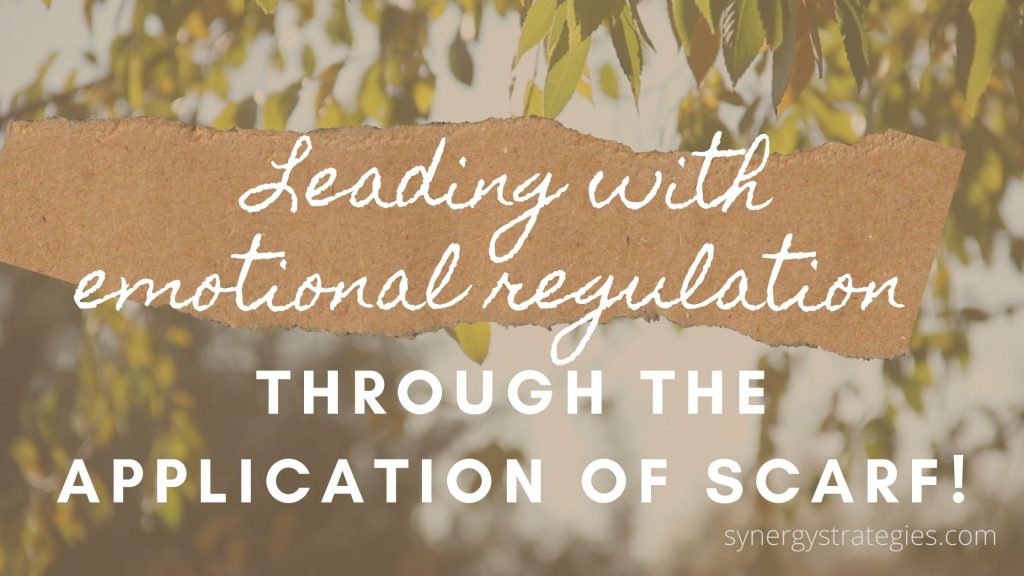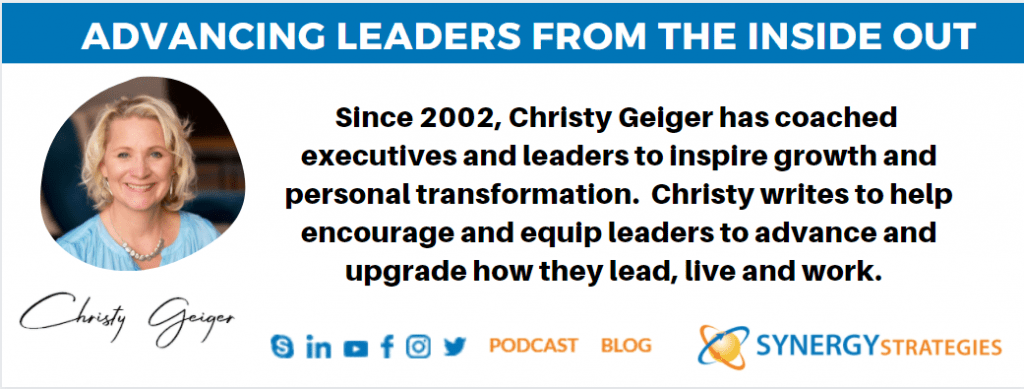Understanding our emotions and how to respond to them, is a growing skill in leadership. Emotional management allows humans to lead better as they understand and support their followers.
Emotions are a natural function that occurs in the brain when the nervous system is aroused. When emotions are activated, our thoughts move from our Prefrontal Cortex (PFC), the region of the brain responsible for overall thought and action such as planning, decision making, personal moderating for rational thinking, to our Limbic System (including the Amygdala, Hypothalamus, Thalamus) where emotions, motivation, learning and memory happens. When we are emotionally activated we can make poor decisions, experience impatience, and have clouded judgment.
The field of Neuroscience has documented what happens when we move from a place of reward or safety (frontal lobe) to activated threat (limbic) as well as how to notice it, label it, and self-regulate it. The SCARF Model, developed by David Rock, points out five key factors that influence our emotions. This model can help us better understand ourselves as well as respond more effectively to others.
First, Personally. Using SCARF, can help us identify triggers, manage our emotions and shift from a limbic mode back to a larger-picture-solution mode. For example, SCARF can help us to diffuse anger or fear by identifying factors that might be activating us. Labeling it then brings a sense of calmness to enable us time to decide how to handle it.
Example: I am in a meeting and presenting research results that had been my 100% focus for the last month. The CEO seems distracted and looks at his phone during my whole presentation. The others interrupt, question, and pushback on my conclusions. The CEO suddenly says we need to cut the meeting short and pick up the discussion next week. I leave the meeting feeling unsettled, irritated, and frustrated. What is going on? I run through SCARF to identify.
- STATUS. Did something cause me to feel I was not important or that I did not matter? (Yes. By the lack of attention from the CEO and the apparent disrespect from my fellow leaders, I felt disrespected and as if my words didn’t matter).
- CERTAINTY. Is there something that is causing doubt, lack of clarity, or my ability to understand expectations or what is happening in the future? (Yes. There were a lot of questions and the plan to talk more next week, but I didn’t know what I needed to prepare, answer, or how to move forward this week.)
- AUTONOMY. Was there something that hijacked my sense of control, freedom, and independence? (Yes. The constant interrupting was rude, derailed my train of thought, and didn’t allow me to follow the presentation as I planned.)
- RELATEDNESS. Was there anything that would cause me to feel like I was not a safe connection with others? (Yes. The response caused me to feel that someone wanted to sabotage my research and had another agenda. I felt a lack of trust for the questions being asked and felt undermined by those I thought shared my passion and perspective.)
- FAIRNESS. Did anything happen that was an unreasonable exchange between me and others? (Yes. The meeting was cut short. It was not given the time promised. Decisions that needed to be made this week cannot be made. The CEO wouldn’t have done that to someone else.)
I can use this process to help label and manage my emotions and reactions. I can teach others around me the model so they can help me process and spot where I might be getting triggered. I can journal on times I am emotional to assess if it is a SCARF factor. I can notice if I begin to feel calmer and ‘above’ a problem after processing (indicating I am moving back to my PFC). It might also be useful to review each day and track which SCARF factors were triggered in the day. At the end of the month, I can tally if there is a factor or two that gets activated more so that I can explore my relationship with that.
Second, Relationally. Awareness of how SCARF affects others is useful. When we listen for these attributes, we can avoid emotionally reacting ourselves and rather, be ready to show understanding and compassion. Additionally, SCARF can be used as a filter for leaders to consider how they communicate messages, how they respond to others, and how they lead forward. SCARF can help leaders to listen to what is being said underneath the words, better relate with their team, recognize an impasse or conflict, and improve communication when sharing an important and sensitive message. Leading through COVID-19 is a great application.
- STATUS. In personal conversations, sit next to someone rather than stand over them. Call them by their name. In larger communications make sure to share that people are important and their safety matters. Provide opportunities for the team to share their thoughts and stay informed.
- CERTAINTY. Share what you can to provide as much security as possible. Ambiguity and indecision are the enemy of certainty. Be clear. IE: “There are a lot of unknowns right now. To help you plan and to allow for the greatest safety while preserving productivity, all teams will be working from home for the next three weeks. We will delay project deadlines one week to give you time to adjust and create a working home office.”
- AUTONOMY. Help people to know what they have control over and what they can do. IE: “Report for your regular shifts, but you can bring approved masks and sanitizer from home. You are welcome to disinfect your station as often as you like, but must do at least once each hour.”
- RELATEDNESS. Help people feel secure. They are part of a tribe and not alone. IE: “We miss you when you are not around. We want to connect. We are in this together and we will get through this together. We want to check in daily at the 8 AM huddle.”
- FAIRNESS. Ensure needs are met fairly. IE. “In April the leadership will take a 25% pay reduction and if this continues into May, as a team, we will reduce weekly hours to 30 and pay accordingly.”
SCARF factors are often interrelated. For example, by sharing an economic plan, a leader helps people feel fairness is happening, gives them certainty of what to expect, and empowers their autonomy to make adjustments and decisions.
SCARF has many applications and can be a constant tool for emotional regulation, personally, and as we lead others. Perhaps a simple measurement of the effectiveness of the tool is to ask on a scale of 1-10 where the person is/was emotionally at the start of a conversation and after applying SCARF factors ask where they are, 0-10.
In my experience of using this in coaching, the application of SCARF reduces the emotional volatility and helps the individual to return to the PFC where they have greater personal power, ideas, and ability to make the decisions they need to move forward. It helps leaders to shift from a place of emotional spinning to a place of balanced action.






